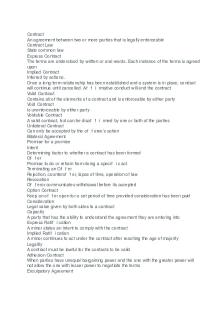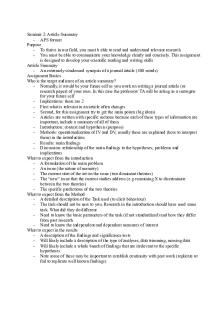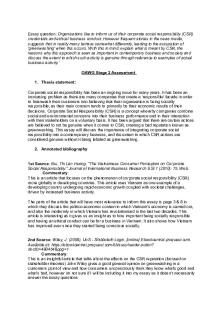Notes 2 PDF

| Title | Notes 2 |
|---|---|
| Course | Computer-Oriented Approach to Statistics |
| Institution | Athabasca University |
| Pages | 6 |
| File Size | 89.1 KB |
| File Type | |
| Total Downloads | 81 |
| Total Views | 134 |
Summary
Unit 2 Notes...
Description
Chapter 4 The outcome of a probability experiment is often a count or a measure. When this occurs, the outcome is called a random variable. Random Variable: (x) represents a numerical value associated with each outcome of a probability experiment. There are two types of random variables: Discrete: if the random variable has a finite or countable number of possible outcomes that can be listed. (usually count data) Continuous: if the random variable has an uncountable number of possible outcomes, represented by an interval on the number line. (usually measured data- age, height and weight are considered continuous variables) (see page 194 for examples of the two above types) A discrete probability distribution lists each possible value the random variable can assume, together with its probability. A probability distribution must satisfy the following conditions. 1. The probability of each value of the discrete random variable is between 0 and 1, inclusive. 2. The sum of all the probabilities is 1. In math form: 1. 0 less than or equal to P(x) which is less than or equal to 1. 2. Sigma P(x) = 1 A discrete probability distribution can be graphed with a relative frequency histogram. Constructing a Discrete Probability Distribution: 1. Make a frequency distribution for the possible outcomes. 2. Find the sum of the frequencies 3. Find the probability of each possible outcome by dividing its frequency by the sum of the frequencies. 4. Check that each probability is between 0 and 1, inclusive, and that the sum is 1. If the distribution is a probability distribution, then 1. Each probability is between 0 and 1 inclusive, and the sum of the probabilities equal 1. Mean: Each value of x is multiplied by its corresponding frequency (or probability) and the results are added. For example:
“x” 1 2 3 4 5
Frequency P(x) 0.16 0.22 0.28 0.20 0.14
1 x 0.16 = 0.16 2 x 0.22 = 0.44 3 x 0.28 = 0.84 4 x 0.20 = 0.80 5 x 0.14 = 0.70 Mean = 2.94
To find variance: 1. Take each “x” variable, and minus the mean from each…. So 1 – the mean (2.94) = -1.94. Do this for every variable. 2. Next square the result of every answer you get. 3. Take all the squared answers and add them up to get the variance. (see page 199, Example 6 for illustrations) To find Standard deviation: Square the variance. The Expected value E(x) is equal to the mean of the random variable. Although probabilities can never be negative, the expected value of the random variable can. To find the net gain, see Example 7, on page 200 for details. Exercises 4.1 5: false 13: discrete 15: continuous 23: 0.22 29: 2,175 households No. of Dogs 0 1 2 3 4 5 Mean = .497
Frequency 0.686 0.195 0.077 0.022 0.013 0.006
“x” - mean -0.497 0.503 1.503 2.503 3.503 4.503
Squared 0.247 0.253 2.259 6.265 12.271 15.774
Frequency x Sqrd 0.169 0.049 0.174 0.138 0.159 0.095
Variance: 0.784 Standard Deviation: 0.885 35: x 0 1 2 3 4 5 6 7 8
P(x) .02 .02 .06 .06 .08 .22 .30 .16 .08
Mean 0 .02 .12 .18 .32 1.1 1.8 1.12 .64
(x – mean) 5.3 4.3 3.3 2.3 1.3 .3 -0.7 -1.7 -2.7
Col. 4 squrd 28.09 18.49 10.89 5.29 1.69 .09 .49 2.89 7.29
P(x) x Col. 5 .562 .369 .653 .317 .135 .019 .147 .462 .583
Mean = 5.3 Variance: 3.247 Standard deviation: 1.802 Expected value: 5. Students seem to get the last four questions correct more often then the first four. 45: n/a Binomial Distribution: A binomial experiment is a probability experiment that satisfies the following conditions: 1. The experiment is repeated for a fixed number of trials, where each trial is independent of the other trials. 2. There are only two possible outcomes of interest for each trial- success (S), or failure (F) 3. The probability of S is the same for each trial. 4. The random variable x counts the number of successful trials. Symbol n P = P(S) q = P(F) x
The number of times a trial is repeated The probability of success in a single trial The probability of failure in a single trial (q = 1 – p) The random variable that represents a count of the number of successes in “n” trials.
Binomial Probability Formula: The probability of exactly x successes in n trials is: (n! / (n – x)!x! )(p^x)(q^n-x) (see page 208 for more details) Two solutions to binomial probabilities: 1. Tree diagram and multiplication rule 2. Binomial Probability formula IMPORTANT! Do the binomial factorials on the Samsung Galaxy using the right brackets… see sheet of paper. By listing all the possibilities of x with the corresponding probability of each, you can construct a binomial probability distribution. Population Parameters of a Binomial Distribution: Mean = u = np (n times p) Variance = o^2 = npq (n times p times q) Standard Deviation = squrt(npq) (square root of n times p times q) Normal Probability Distributions: (Chapter 5) A normal distribution is a continuous probability distribution for a random variable ‘x’. The graph of a normal distribution is called the normal curve. A normal distribution has the following properties: 1. 2. 3. 4.
The mean, median, and mode are equal. The normal curve is bell-shaped and is symmetric about the mean. The total area under the normal curve is equal to one. The normal curve, approaches, but never touches , the x-axis as it extends farther and farther away from the mean. 5. Between u – o and u + o (in the center of the curve), the graph curves downward. The graph curves upward to the left of u – o and to the right of u + o. the points at which the curve changes from curving upward to curving downward are called inflection points. (see pic on page 240) Inflection points are one standard deviation from the mean. The standard normal distribution: Standard normal distribution has a mean of 0 and a deviation of 1. You can transfer an x value into a z score using: Z = (value – mean) / standard deviation (or (x – p) / o)
If the normal distributed random variable x is transformed into a z score, the result will be the standard normal distribution. Properties of the Standard Normal Distribution: -
The cumulative area is close to 0 for z-scores close to z = -3.49 The cumulative area increases as the z-scores increase The cumulative area for z = 0.5000 The cumulative area close to 1 for z-scores close to z = 3.49
See page 245 for guidelines on finding areas under the Standard normal curve. Exercises 5.1: 17: 0.5 – 0.8849 z = .3849 19: .2776 – 9332 z = .6556 21: z = .9131 29: z = .00515 35: .0630 - .5 z = .437 53: .9265 All the above are correct Exercises 5.2: 7: 0.3159 9: 0.2789 13: A: 11.51 percent B. 67.3 percent C. 78.81 percent 15: A: 04.75 percent B. 9.18 percent C. 03.51 percent 21: A: 80.23 percent B: 33.72 percent
To transform a z-score to an x-value, use: x = u + zo See this section for help on finding specific data values for a given probability (page 264) Exercises 5.3: 1: 0.7 9: -1.655 15: 57.93 17: 81.06 25: -0.38 27: 0.58 39: A: 66.67 B: 64.28 43: 127 + .6179 x 23.5 = 141.52 days 45: 20 + .07 x .5199 =...
Similar Free PDFs

MNB1501-Notes-2 - NOTES
- 24 Pages

2 - Lecture notes 2
- 5 Pages

Notes 2
- 6 Pages

Notes 2
- 17 Pages

2 - notes
- 11 Pages

Notes 2
- 3 Pages

2 Biodiversity - Lecture notes 2
- 33 Pages

Chapter 2 - Lecture notes 2
- 30 Pages

Blaw 2 - Lecture notes 2
- 4 Pages

Chapter 2 - Lecture notes 2
- 4 Pages

Seminar 2 - Lecture notes 2
- 2 Pages

Stage 2 - Lecture notes 2
- 3 Pages

Micro 2 - Lecture notes 2
- 18 Pages

2 Sources - Lecture notes 2
- 4 Pages

Prof 2 - Lecture notes 2
- 3 Pages
Popular Institutions
- Tinajero National High School - Annex
- Politeknik Caltex Riau
- Yokohama City University
- SGT University
- University of Al-Qadisiyah
- Divine Word College of Vigan
- Techniek College Rotterdam
- Universidade de Santiago
- Universiti Teknologi MARA Cawangan Johor Kampus Pasir Gudang
- Poltekkes Kemenkes Yogyakarta
- Baguio City National High School
- Colegio san marcos
- preparatoria uno
- Centro de Bachillerato Tecnológico Industrial y de Servicios No. 107
- Dalian Maritime University
- Quang Trung Secondary School
- Colegio Tecnológico en Informática
- Corporación Regional de Educación Superior
- Grupo CEDVA
- Dar Al Uloom University
- Centro de Estudios Preuniversitarios de la Universidad Nacional de Ingeniería
- 上智大学
- Aakash International School, Nuna Majara
- San Felipe Neri Catholic School
- Kang Chiao International School - New Taipei City
- Misamis Occidental National High School
- Institución Educativa Escuela Normal Juan Ladrilleros
- Kolehiyo ng Pantukan
- Batanes State College
- Instituto Continental
- Sekolah Menengah Kejuruan Kesehatan Kaltara (Tarakan)
- Colegio de La Inmaculada Concepcion - Cebu
